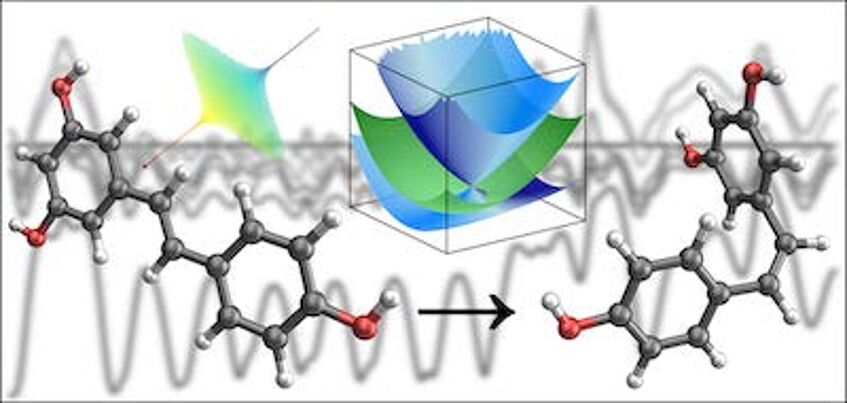Simulation of light-induced dynamics in complex molecules
Simulation of light-induced dynamics in complex molecules
Research questions:
Mechanistic studies of light-induced processes in molecules with many degrees of freedom are still a challenge [1] but an avoidable one in order to interpret and guide time-resolved spectroscopy. In this project we will use and develop methods to investigate the photophysics and photochemistry of complex (bio)molecules in gas phase to aid laser driven matter-wave interferometry experiments, as performed in the group of Arndt and complemented by the spectroscopic measurements.

Laser-induced photoisomerization dynamics
in resveratrol through conical intersections
(schematic).
Methods:
The theoretical framework will be a combination of advanced quantum chemistry and non-adiabatic trajectory surface-hopping dynamics, as implemented in our local code SHARC [2]. This combination allows mapping the geometrical changes that a molecule undergoes in real time and the precise identification of the population of different electronic excited states under light stimuli [3]. Besides identifying deactivation pathways, the PhD student will investigate the response of the electronic states to explicit external forces. These include intense electric fields, which can shape and shift potential energy surfaces [4], as well as magnetic interactions. An optimization of the parameters controlling these interactions can be used to tailor specific functions. The macromolecules chosen will feature singlet-triplet transitions in extended aromatic organic molecules, photoisomerizations as well as other conformational changes in vitamins and biological molecules – all molecular systems that can be used as probes to observe matter-wave fringes.
Time frame:
Months 1-6: Calculation of electronic excited states and relevant chemical reaction paths; months 7-19: excited state dynamics; months 20-27: dynamics including explicit electric fields; months 28-42: eect of magnetic fields; months 43-48: writing of papers and thesis.
Participating DCAFM-faculty:
L. González (PI), M. Arndt (magnetic detection of photoisomerization), C. Franchini (calculation of molecular magnetism), T. Pichler (molecular spectroscopy)
[1] P. Marquetand, J. J. Nogueira, S. Mai, F. Plasser, L. González, Molecules 22, 49, (2017), DOI: 10.3390/molecules22010049.
[2]S. Mai, P. Marquetand, L. González, Wiley Interdiscip. Rev. Comput. Mol. Sci. 8, e1370(2018), DOI: doi.org/10.1002/wcms.1370.
[3] S. Mai, N. Dunn, L. Martinez-Fernandez, M. Pollum, P. Marquetand, I. Corral, C. Crespo-Hernández, L. González, Nat. Commun. 7, 13077 (2016), DOI: 10.1038/ncomms13077.
[4] M. Waldl, M. Oppel, L. González, J. Phys Chem. A120, 4907 (2016), DOI:10.1021/acs.jpca.5b12542.
